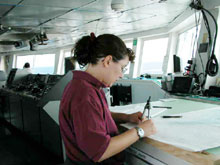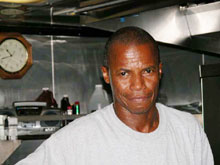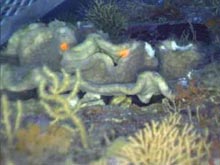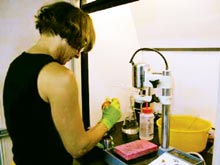'Oh My Gosh, it's a Lithistid!'
September 14, 2003
Shirley A. Pomponi, PhD
Co-Principal Investigator, Deep Sea Medicines Expedition
Vice President and Director of Research
Harbor Branch Oceanographic Institution
Taconya D. Piper
NOAA Office of Ocean Exploration
As members of the science team brought back baskets one by one from the ROV (remotely operated vehicle), there was more chatter than usual in the wet lab. The talk centered on interesting-looking sponge in one of the buckets. As people moved methodically around the lab labeling, cataloguing, and photodocumenting the samples, Dr. Shirley Pomponi exclaimed, "Oh my gosh, it's a Lithistid!"
Why so much excitement about yet another beautiful sponge? Although I am a fisheries biologist by training, I am being schooled on "more than I ever wanted to know" about sponges, corals, and other sessile underwater organisms. I am also recalling many of the lessons I learned in undergraduate biology and cell biology. As it turns out, Lithistids are a very rare group of sponge (a family, taxonomically speaking) not normally found at depths as shallow as today's dive (~235 ft.). They are usually found at depths of 1,000-2,000 ft, and typically have very "good chemistry." Good chemistry, a term I have come to know during these past few days, is the result of cell cultures that yield compounds that may lead to useful biomedical products in the treatment of cancer and other diseases.
The lithistid, while beautiful to behold, proved very hard to subsample, and broke apart easily when heavy-duty tools were used to cut it (we tried regular shears but they just didn't "cut it").
"We want to run HPLC right away," Dr. Pomponi told Gail Samples, another HBOI scientist. When I asked Dr. Pomponi about this test, she explained that its preliminary results determined that our Lithistid has "typical chemistry for that group of sponge." The scientists will, of course, study it very closely when they returned to the their laboratory.
I am constantly amazed by the sheer variety of sponges and corals being found during the ROV dives. It is also intriguing to watch the scientists get excited about things I thought they would have seen time and time again. I actually thought that our work might, at times, become routine and borderline boring. They have definitely proven me wrong. This mission makes it clear how important it is to continue to explore the oceans and their resources. Who knows? The next unusual or rare organism recovered during a dive could result in a cure for cancer, Parkinson's, Alzheimer's or diabetes. Wouldn't _that_ sponge be a beautiful sight?

NOAA Corps Officer LTJG Jennifer Pralgo looks over a navigational chart. Lieutenant Pralgo is in charge of navigation on the NOAA Ship Ronald H. Brown. Click image for larger view.
Kudos to the Ron Brown Crew
Gary K. Wolfe
Marine and Environmental Education
Eau Gallie High School
Rollins College Brevard
It's day seven of our bioprospecting expedition, and our journey brings us to a ridge on the continental shelf known as Madison-Swanson. Located near the Florida panhandle, this site has been designated as a marine reserve due to its unique hard-bottom habitats and the high biodiversity of commercially important species of fish, such as grouper and snapper. The benthic diversity of this area will offer the Harbor Branch scientists an assortment of marine life to test for biomedical potential.
We will be diving at sites along these ridges all day today. ROV operations have become very smooth at this point, in contrast to when we began the expedition a week ago. By the time the second leg of the expedition begins on September 22, the logistics among the various groups on board should be second nature. We have the officers and crew of the NOAA Ship Ronald H. Brown to thank for keeping the momentum going.
Operating a 274-ft ship is no easy task. There are six departments on board, and all have individual operations. The key factor for success is the constant flow of communication from one department to another. Clear communication among all departments is essential to accomplishing the goals of each mission.
"In this job, you have to be a problem solver without wasting a lot of time," says Chief Boatswain (pronounced "bosun") Bruce Cowden. "Situations aboard a NOAA ship are subject to constant change, so challenging scenarios are always coming up at a moment's notice. If you take too long to resolve a problem due to a breakdown of communication, your may not meet your goals, or, even worse, someone could get hurt or even killed."

Chief Steward Richard Whitehead pauses for a single moment in the midst of preparing another delicious meal. Click image for larger view.
Working on a NOAA vessel is not a job for everyone. With up to 10 months at sea at a time, it is difficult to have a normal family life. On the other hand, the positive aspects can be very fulfilling. The job is rarely boring. You get to travel quite a bit and see things that many people will never witness. On one trip you might be in the middle of the Pacific Ocean servicing buoys, while on another, you could be in the middle of the Atlantic conducting research on Sahara dust storms and their effects on climate. Many of the NOAA crew members are fascinating by the scientific research conducted on board, and interact with the scientists with genuine curiosity and fascination.
From the captain down, crew members knows that the work they do is important. A common thread during my discussions with the crew is that they take pride in doing their jobs well. From weather information, forecasting, and warnings that may result in the saving of lives and the protection of property, to the management of coastal resources, the NOAA Corps has actively enhanced our lives with science, service, and stewardship for 34 years. Kudos to the crew of the NOAA Ship Ronald H. Brown and the rest of the NOAA Corps for a very important job well done.
Sign up for the Ocean
Explorer E-mail Update List.























